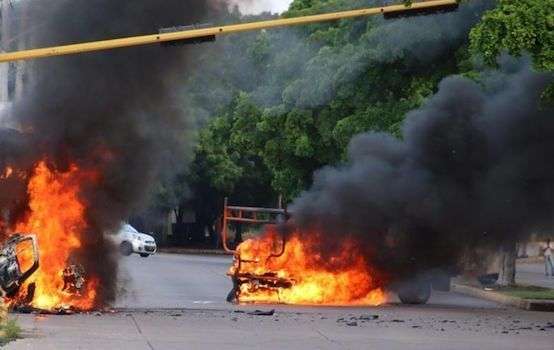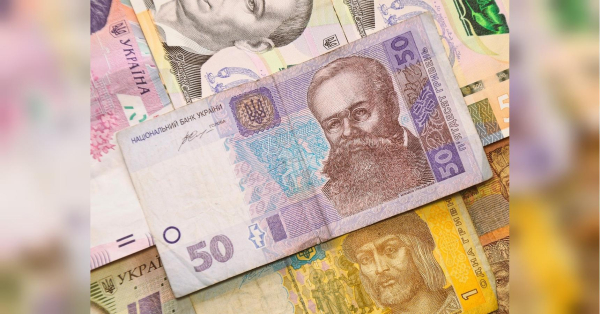
While American media outlets have been trashing the Trump administration over its abandonment of America’s “noble Kurdish allies” in Syria, they have paid little attention to an extraordinary and alarming development in Mexico. This week, criminals actually declared open season on the Mexican government—and won.
As part of an ongoing campaign against the country’s powerful cartels, Mexican security forces arrested two sons of former Sinaloa cartel kingpin Joaquin “El Chapo” Guzman in mid-October. Presently, the elder Guzman languishes in a maximum security prison in the United States. Mexican officials seemed to believe that taking his sons out of commission might sound the death knell for the rump Sinaloa organization.
It proved to be disastrous. Multiple battles soon erupted between government forces and cartel gunmen in the streets of Culiacan, Sinaloa’s state capital. The cartel attackers quickly freed Ivan, the eldest son. Ivan then launched an all-out siege of Culiacan in an effort to free his younger brother, Ovidio. Writing in the Federalist, analyst John Daniel Davidson described the chaotic situation:
The ensuing scene could have been mistaken for Syria or Yemen. Footage posted on social media showed burning vehicles spewing black smoke, heavily armed gunmen blocking roads, dead bodies strewn in the streets, and residents fleeing for cover amid high-caliber gunfire.
Advertisement
Armed with military-grade weapons and driving custom-built armored vehicles, cartel henchmen targeted security forces throughout Culiacan, launching more than one dozen separate attacks on Mexican security forces. They captured and held hostage eight soldiers, then kidnapped their families. Amid the fighting, an unknown number of inmates escaped from a nearby prison. At least eight people were killed and more than a dozen were injured.
The eight-hour battle ended when government forces, outgunned and surrounded, without reinforcements or a way to retreat, received an order directly from Mexican President Andres Manuel Lopez Obrador to release their prisoner and surrender.
Ioan Grillo, a longtime expert on Mexico’s drug trade and its accompanying violence, provided a similar picture, and stressed its depressing implications. He noted that
the cartel gunmen were everywhere. They openly drove in trucks with mounted machine guns, blockaded streets flashing their Kalashnikovs and burned trucks, unleashing plumes of smoke like it was a scene in Syria. They took control of the strategic points in the metro area, shut down the airport, roads, and government buildings and exchanged fire with security forces for hours, leaving at least eight people dead. In contrast, everyone else had to act like ghosts, hiding behind locked doors, not daring to step outside.
- Mexico Must Stand Up to America’s Drug War
- El Chapo: Another Case for Ending the Drug War
This was all happening barely 600 miles from America’s Southern border. Drug cartel forces defeated troops of Obrador’s newly created National Guard in a full-blown battle. Yet U.S. press coverage was minimal—utterly dwarfed by the attention devoted to developments in Syria. That imbalance needs to change and change quickly.
The overall level of drug-related violence in Mexico has reached horrifying levels, exceeding even those that characterized the 2006-2012 period during President Felipe Calderon’s misbegotten militarized anti-drug crusade. Homicides, the vast majority of which are related to the drug trade, exceeded 33,300 in 2018. That was a whopping one-third increase over 2017, which was itself a record year. During the first half of 2019, the carnage came at a similar pace. Even before the 2019 figures were released, more than 135,000 victims had perished since 2012, when Calderon left office.
The Sinaloa cartel may not even be the Mexican government’s most capable adversary. At the zenith of El Chapo’s power, his organization controlled an estimated 50 percent of Mexico’s illegal drug trade. That dominance reduced the number and virulence of turf fights. Not only was there a declining number of rival cartels, but the remaining players hesitated to confront Guzman’s daunting power. His capture, extradition, and imprisonment has amounted to a hollow victory for both Mexico and the United States. The struggle for lucrative trafficking routes is now unprecedented in its scope and virulence, as at least seven gangs vie for dominance.
The ascendant power appears to be the Jalisco New Generation cartel (better known by its Spanish acronym, CJNG). That group is renowned for a ruthlessness and level of sadistic violence that exceeds nearly anything Sinaloa or its competitors have exhibited. One analyst concludes that CJNG is clearly winning the “narco game of thrones.” Moreover, a transformation in the fighting capabilities of CJNG and other cartels makes them an increasingly potent threat to the authority of the Mexican government.
Grillo emphasizes that the Culiacan episode was the result of a trend over many years in which the cartels have developed deadly “insurgent tactics.” He notes that “the use of burning vehicles to block roads was taken from militant protesters; cartels use it to stop the movement of troops and put pressure on the government.” Perhaps most alarming, Grillo contends, the cartels “have armed up with stolen military weapons.” What occurred in Culiacan, he adds, “wasn’t gangster action; it was a mass insurrection.”
Raul Benitez, an expert on Latin America’s armed conflicts, warns that “the Sinaloa Cartel demonstrated a tremendous ability to mobilize rapidly and take effective control of the city.” The implications are profound, Benitez concludes. Armed cartel personnel “showed that in Sinaloa, they are the ones who run things.”
Davidson contends that “the battle of Culiacan marks a turning point in the collapse of the Mexican state. There is now no doubt about who is in control of Sinaloa.” Like Grillo, he believes that “what’s happening in Mexico right now is more like an insurgency” than a typical turf fight in the long-raging drug war. In his view, “Mexico is now on a trajectory to become a vast gangland governed more by warlordism than by the state.”
Such a dire conclusion is somewhat premature. Despite previous predictions that Mexico was on the brink of becoming a failed state, the society and political system have proven to be surprisingly resilient. Nevertheless, the spike in drug war-related fatalities over the past four years, the growing strength of the CJNG, and especially the emergence of sophisticated insurgent tactics by the cartels (as exemplified in the Culiacan battle) are all extremely alarming developments.
The United States has an emerging crisis in a country on its own border. U.S. leaders and the American news media need to pay far more attention to this ominous trend, instead of being obsessed with events halfway around the world that have marginal relevance (at most) to the republic’s security.
Ted Galen Carpenter, a senior fellow in security studies at the Cato Institute and regular contributing editor at The American Conservative, is the author of 13 books on international issues, including two books on drug violence and corruption in Latin America: Bad Neighbor Policy Washington’s Futile War on Drugs in Latin America (2003), and The Fire Next Door: Mexico’s Drug Violence and the Danger to America (2012).
Sourse: theamericanconservative.com






